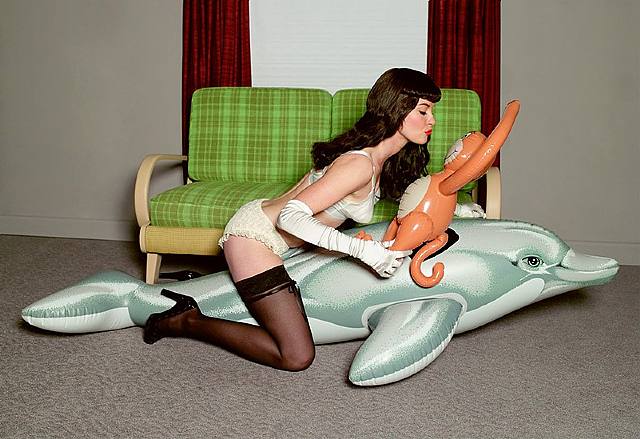
Jeff Koons, "Girl with Dolphin and Monkey" (The Whitney Museum of American Art 75th Anniversary Photography Portfolio), 2006. Courtesy Whitney Museum
The eerily small, closely watched world of New York art criticism experienced some infighting earlier this month, following the publication of February’s The Brooklyn Rail. “I think that there are some things you shouldn’t do, and promoting Jeff Koons is one of them,” wrote Rail editor John Yau, picking a fight with critic Jerry Saltz, who had championed Koons (featured in Season Five of Art:21) as “the emblematic artist of the decade” in New York Magazine’s end-of-the-00s issue. Saltz had also declared Koons’s work emblematic of America—it’s “crowd-pleasing, heat-seeking, impeccably produced, polished, popular, expensive, and extroverted—while also being abrasive, creepily sexualized…” It’s this last part that Yau resented; he titled his editorial The Difference Between Saltz’s America and Mine. “In Saltz’s America,” he quipped, “Puppy is great public art and Tom Cruise is the good, handsome German with an eye patch, trying to save the world from Hitler.” Saltz retaliated via his Facebook page, calling Yau “dickish,” “incoherent,” “self-satisfied,” and “irrelevant.” It wasn’t a pretty moment for art writing.
I care about what Yau and Saltz say — partly because I’m a writer, and knowing what other, more visible writers write is part of my job — but also because both of them have influenced me. Yau’s Corpse and Mirror gave me new entry into abstraction, while Saltz taught me that Charles Ray can be likable and that lush adjectives can be applied to austere conceptualism. A lot of other writers and artists care too. So much so that I’m noticeably late to comment on the Saltz-Yau tiff. Art21 contributor Hrag Vartanian “broke” the story; Tyler Green of Modern Art Notes spoke up for Yau; artist William Powhida invited the critics to debate at #class; C-Monster, art blogging’s straightest shooter, kept tabs on the squabble; poet Michael Leong wrote that Saltz hadn’t found “enough critical distance to say anything productive” (and received a retaliatory comment from Saltz). Some — Vartanian, Leong and Green in particular — did justice to the ethical problem Yau had with Saltz. But there’s another more frustrating ethical problem integral to all of this. This problem has little to do with either critic’s ultimate point. Those were actually reasonable: Saltz said that Koons embodied an era in American culture; Yau said Koons didn’t, and that saying so evidenced tunnel-vision. The problem has to do with how they went about arguing.
Jeff Koons, "Puppy," June 6 - September 5, 2000 at Rockefeller Center. Steel, soil, plants.
Saltz spun into his essay with characteristic zest, presenting an art decade that began with seemingly utopian “happy complacency” (he offers no examples of this complacency) but quickly turned hierarchical. As the shadow of the wars in Afghanistan and Iraq settled over America, producers like Damien Hirst, Takashi Murakami, and Koons (all of whom had been well-established by the end of the ‘90s) came to reign in a sort of high-priced boys’ club. Koons wasn’t a full-blown member of the club, however. It’s hard to tell exactly why, since the way Saltz describes him—“one-at-a-time perfection,” “theatricality,” “almost sick”—seems equally applicable to the artists of the diamond skull and the Superflat. But, says Saltz, Koons’s 40-foot, flower-laden, internally irrigated Puppy, stood apart as an embodiment of the American id. This argument soon becomes a swirl of strangely incongruous but passionate observations, a let-loose pontification that might make for a gripping performance, but seems ill-equipped as cultural criticism: Koons doesn’t go in for “art-about-art gesture” yet Puppy is still a “virtual history of art”; Koons attempted to make something “beyond criticism” yet Puppy occupied that loaded, critically vulnerable space at Rockefeller Center; Puppy inaugurated “this decade’s public-spectacle art” yet it had been prominent throughout the ‘90s; Puppy ended bliss and announced the coming deluge yet, if the deluge hit so early, what role did Puppy play during the remaining nine years it supposedly embodied? The stakes are high when a high-profile critic sets apart a single artist as emblematic of anything, let alone a decade, and the stakes are equally high when another only-slightly-less-high-profile critic uses 2000+ words to object.
Yau’s essay, like Saltz’s, begins energetically, comparing the offense Yau took at Saltz’s “paean to Jeff Koons’s Puppy” to Bill Hicks‘s outrage when already-famous Jay Leno sold Doritos. What good does that sort of shilling do anyone? Yau quickly points out that, mainly, he objects to “[Saltz’s] blithe characterization of ‘our America.’” Yau does briefly describe the America Koons represents: “though [Koons] is spoiled, he is also ambitious and productive . . . no different than the CEOs and real estate barons who buy his work.” He also describes the America he himself prefers, in which “people know that there are works that will not likely ever be shown in a museum or multiplex . . . but that doesn’t mean they shouldn’t be kept alive.” Yet he spends so much time scrutinizing Koons’s personality traits, equating Saltz with Koons, and quoting his own past writing, that he seems to be on the defensive, or at least bent on proving his own prescience. No unethical opinions exist in art criticism— believing that art should be crowd-pleasing is as justified as believing art should “afflict the comfortable.” But there are unethical ways of arguing. It’s a critic’s responsibility to try to glance past his own worldview—not to escape it (that would be impossible and uninteresting)—and invite conversation about more than what he thinks. Writing that settles for voluptuous, only half-substantiated opinion-making, breaks the rules.